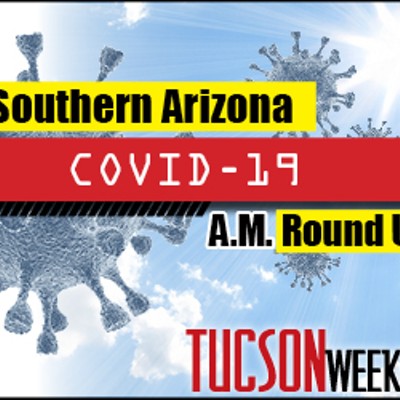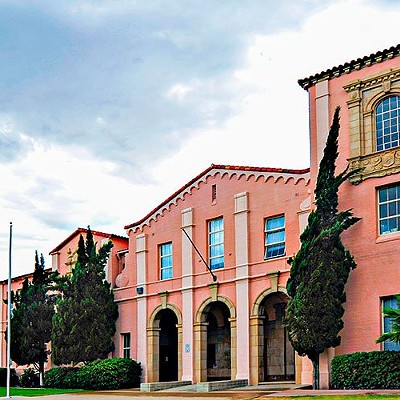TUSD's Technology and Telecommunication Services Department worked with an Alabama consultant this year to prepare an apparently unsuccessful application. For 2007, the district is turning the responsibility over to its director of resource development, who will be assisted by a California consulting firm.
Despite the change, TUSD school board member Judy Burns isn't overly optimistic.
"It could work," she says, "but the problem is: It's November. We're pretty much scrambling again. We're running out of time."
The history of TUSD's E-Rate futility started in 2003. After three successive years of failures to obtain any grant money--which pays for telephone bills as well as technology upgrades--the TUSD governing board last February voted to apply for $35 million (See "Communication Breakdown, June 8).
Even though TUSD officials originally had high hopes, on June 27, Superintendent Roger Pfeuffer talked with the school board about abandoning the two controversial 2006 E-Rate applications, since he believed the district wasn't going to get the money anyway.
Instead of approving the abandonment of the applications, the board instead voted 3-2 to "fund staffing positions necessary to provide quality service for management of TUSD's E-Rate application process."
Prior to this vote, Pfeuffer made it clear how he wanted to proceed. "You're approving the expenditure of bonds funds," he told the board, "to put together the in-house ability to sustain an E-Rate program."
Indicating he thought the new person employed to oversee the effort would be paid between $80,000 and $90,000 a year, Pfeuffer also discussed hiring a consulting firm to help out.
More than four months later, nobody has been hired. Instead, Pfeuffer has turned the E-Rate duties over to Lorrane McPherson, the district's executive director for resource development.
"We'll do as much as we can in-house, while evaluating what needs (to meet) if we hire someone. ... Just to hire more people isn't the point," explains McPherson.
At the same time, McPherson says district officials are discussing what to include in a 2007 E-Rate application, an uncertainty which concerns Burns.
"They haven't written requests for proposals or gone out to bids for services yet, so (the school board) will have the same schedule as last year," Burns says about of the complex, time-consuming process. Last year, this last-minute situation had the E-Rate applications being approved in a rushed fashion only a few hours before the deadline.
This déjà vu comes just as the 2007 E-Rate application process is getting underway. Requests for 2007 funds will be accepted beginning on Nov. 14 and continue until Feb. 7, 2007.
TUSD has also employed a California consulting firm to assist McPherson. Mark Miller, of the Miller Institute for Learning With Technology, indicates he's impressed by the people at TUSD.
Despite the fact that dozens of other Arizona school districts have successfully applied for E-Rate funds in the last few years--while TUSD has repeatedly failed--Miller says the district is trying to do a good job.
"I think we'll have a much more successful application in the coming year," Miller predicts hopefully.
Meanwhile, at the school board's Nov. 14 meeting, Burns anticipates questioning a draft technology infrastructure plan the district has prepared. Having seen an early version of the 50-page document, she calls it "pretty vague," while stating its estimated cost is $38 million, with substantial reductions in price possible.
In part, this plan is supposed to spell out what technology hardware the district now has, and what its future needs are. Plus, it could also be the basis for future E-Rate applications.
The plan will reportedly recommend installing a wireless communication network to outlying schools--such as Sabino High School--while relying on land lines inside the city limits. This is an important distinction, because part of the controversy over the 2006 E-Rate application was whether TUSD would go completely wireless.
Burns is additionally confused about the action Pfeuffer took to cancel the 2006 E-Rate applications. Instead of abandoning them both, as he discussed with the school board in June, the superintendent did something else.
Of the $35 million originally requested, Pfeuffer asked in an Aug. 17 letter that consideration of funding for services provided by Qwest, Verizon and Schoolwires Inc., totaling almost $1.5 million a year, be kept active. TUSD has not yet learned the status of that $1.5 million request.
While questioning why the school board wasn't informed of this move by Pfeuffer, Burns isn't necessarily unhappy about it. "I didn't want us to lose out on the telecommunications money," she says. "We have a legitimate right to it."
Another lingering doubt surrounding the district and its E-Rate program concerns an ongoing investigation by the Arizona Attorney General's Office. At the request of the school board, the AG is looking into the purchasing procedures TUSD used to assemble its 2006 application bids.
A source tells the Weekly that two weeks ago, five district employees were interviewed under oath as part of the investigation. Speculation floating around TUSD is that a finding in the case could be rendered shortly.
Meanwhile, Burns says she is all alone on the TUSD board in her critical questioning of how Pfeuffer is running the district.
"They looked at me as if I had some kind of plague," Burns says about the reaction from her fellow board members during a recent evaluation of the superintendent's job performance. "For them, Roger walks on water."












